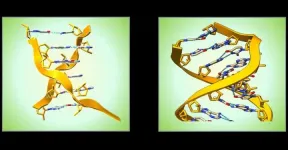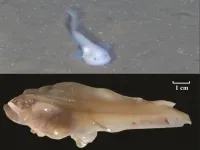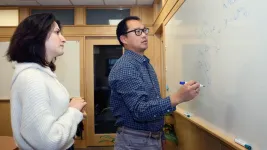Understanding how people make sense of the news they consume
University of Missouri researchers hope their findings can be translated into better user experiences for consuming news on digital news platforms
2021-05-13
(Press-News.org) How people consume news and take actions based on what they read, hear or see, is different than how human brains process other types of information on a daily basis, according to researchers at the University of Missouri School of Journalism. While the current state of the newspaper industry is in flux, these journalism experts discovered people still love reading newspapers, and they believe a newspaper's physical layout and structure could help curators of digital news platforms enhance their users' experiences.
"Many people still love print newspapers, and to an extent, we also see that they like the digital replicas of print newspapers as much as they do the physical version," said Damon Kiesow, a professor of journalism professions and co-author on the study. "But we believe there is more to understanding this notion than just simply habit and experience. We feel newspapers are fulfilling some sort of need in a person's daily life that is not currently being effectively fulfilled with the digital experience. The contextual clues that help tell readers what stories are important, why they should care about what stories they are reading and where to locate the news that is most important to them, are being weakened by structures missing in digital news."
The study is based on psychologist James Gibson's theory of "affordances," which argues an object's properties indicate what desired action should be taken with the object. The researchers believe this theory can apply to print newspapers in the way that various surfaces, layout, colors and labels can help contextualize a news story and give it meaning to the reader. By conducting in-depth interviews with 12 long-time newspaper subscribers, the team was able to identify 10 affordances of people who read print newspapers. They are:
Physical affordances, or the ability to physically hold something, navigate a newspaper's defined sections and pages, and create a physical archive of multiple editions for later viewing.
Perceived affordances, or the ability to determine a story's importance, how visual elements are added for contextual purposes, to allow readers to express feelings of possession, and to allow readers to distinguish between different topics of interest.
Relational affordances, or the ability to generate trust, to allow the reader to either actively or passively seek information, and to allow for the discovery of unexpected information.
By better understanding these affordances, the researchers now believe print newspapers have moved to digital platforms without first having a proper understanding of how readers use printed contextual clues to make sense of the news. Kiesow, who has a background in human-computer interfaces, believes these affordances can help inform news organizations when making decisions on their digital platforms to deliver the day's news.
"There is a need for better understanding how print-centric workflows and publishing tools might be hampering readers' understanding of the news on digital platforms," Kiesow said. "Publishers should be looking at elements such as navigation and labels, but also how contextual signals are carried across platforms, including social media, where first impressions of what the news is about are often initially formed before a click occurs. What news organizations should be doing is testing and designing their digital platforms more for understanding, rather than just usability."
Shuhua Zhou, a professor of journalism studies and corresponding author on the study, focuses his research on how people learn from the news. He said Gibson's theory can help explain the many perceptions of the news that people have.
"Gibson has a beautiful theory to help explain whatever we do as human beings, that there are meanings that we assign to those actions," Zhou said. "His use of affordances focuses on what can be done, or the action-potential. Here, we can think about news consumption in a similar way. When a reader sees a headline, the style -- bold type and font size -- gives the news story some type of meaning to that person. That is the action-potential that Gibson refers to in his theory. So, by using this theoretical concept, it can help us better understand why people perceive the news in the way that they do. I think the problem with most newspaper websites is that they are built without thinking about the features which are conductive to readers taking in and making sense of information."
INFORMATION:
The study, "The Values of Print: Affordances and Sensemaking for Newspaper Consumers," was published in Journalism Practice. Lei Guo from the University of Nebraska-Omaha is also an author on this study. Funding was provided by the Donald W. Reynolds Journalism Institute housed at the Missouri School of Journalism.
ELSE PRESS RELEASES FROM THIS DATE:
2021-05-13
In a paper published in the May 13th, 2021 issue of PLOS Genetics, a Z-RNA nanoswitch that regulates interferon immune responses is described. The switch, less than 5 nanometer in length, is based on sequences, called flipons, that change outcomes by altering their three dimensional conformation. The Z-RNA nanoswitch flips from the shorter right-handed A-RNA helix ("on") to the longer left-handed Z-RNA helix ("off"). The flip ends immune responses against self RNAs, but not against viruses. Surprisingly, the Z-RNA nanoswitch sequence is encoded by "junk DNA". The Z-RNA nanoswitch is used by some cancers to silence anti-tumor immune responses. In other cases, a malfunction of the Z-RNA nanoswitch causes inflammatory disease.
In the ...
2021-05-13
A new strategy for capturing the 3D shape of the human face draws on data from sibling pairs and leads to identification of novel links between facial shape traits and specific locations within the human genome. Hanne Hoskens of the Department of Human Genetics at Katholieke Universiteit in Leuven, Belgium, and colleagues present these findings in the open-access journal PLOS Genetics.
The ability to capture the 3D shape of the human face--and how it varies between individuals with different genetics--can inform a variety of applications, including understanding human evolution, planning for surgery, and forensic sciences. ...
2021-05-13
Mutations in two genetic regions in dogs explain over one third of the risk of developing an aggressive form of hematological cancer, according to a study led by Jacquelyn Evans and Elaine Ostrander at the National Human Genome Research Institute in Maryland, USA and colleagues. The study, which combined multiple sequencing techniques to investigate histiocytic sarcoma in retriever dogs, publishes May 13 in the open-access journal PLOS Genetics.
Histiocytic sarcoma is an aggressive cancer of immune cells, and although extremely rare in humans, it affects around one-in-five flat-coated retrievers. Genome-wide association surveys of 177 affected and 132 unaffected flat-coated ...
2021-05-13
A new whole genome sequence for the Yap hadal snailfish provides insights into how the unusual fish survives in some of the deepest parts of the ocean. Xinhua Chen of the Fujian Agriculture and Forestry University and Qiong Shi of the BGI Academy of Marine Sciences published their analysis of the new genome May 13th in the journal PLOS Genetics.
Animals living in deep-sea environments face many challenges, including high pressures, low temperatures, little food and almost no light. Fish are the only animals with a backbone that live in the hadal zone--defined as depths below 6,000 meters--and hadal snailfishes live in at least five separate marine trenches. Chen, Shi and their colleagues constructed a high-quality whole genome sequence from the Yap ...
2021-05-13
Artificial intelligence (AI) learning machines can be trained to solve problems and puzzles on their own instead of using rules that we made for them. But often, researchers do not know what rules the machines make for themselves. Cold Spring Harbor Laboratory (CSHL) Assistant Professor Peter Koo developed a new method that quizzes a machine-learning program to figure out what rules it learned on its own and if they are the right ones.
Computer scientists "train" an AI machine to make predictions by presenting it with a set of data. The machine extracts a series of rules and operations--a model--based on information it encountered during its training. Koo says:
"If you learn general ...
2021-05-13
QUT air-quality expert Distinguished Professor Lidia Morawska is leading an international call for a "paradigm shift" in combating airborne pathogens such as COVID-19, demanding universal recognition that infections can be prevented by improving indoor ventilation systems.
Professor Morawska led a group of almost 40 researchers from 14 countries in a call published in Science for a shift in standards in ventilation requirements equal in scale to the transformation in the 1800s when cities started organising clean water supplies and centralised sewage systems.
The international group of air quality researchers called on the World ...
2021-05-13
For decades, governments worldwide have invested great deals of legislation and resources in food safety, sanitation and drinking water quality for public health purposes. However, the same cannot be said for the air quality of indoor public spaces, wherein the spread of airborne pathogens - whether those that cause the common cold or COVID-19 - is generally considered to be an "inescapable part of daily life." In a Policy Forum, Lidia Morawska and colleagues argue for a profound shift in how policymakers and building engineers view and approach indoor air quality and health, to reduce the spread of respiratory infection. According to Morawska et al., similarly to how food and waterborne disease ...
2021-05-13
A subpopulation of neurons in the brain's zona incerta, or "zone of uncertainty," drives investigatory and novelty-seeking behavior in mice, according to a new study. The findings reveal a previously unknown brain circuit underlying innate curiosity; its discovery may one day have implications as a therapeutic target in animals or people who exhibit novelty-seeking behaviors, authors of a related Perspective say. Although curiosity - the motivational drive to investigate the unknown - is widely considered to be as intrinsic as hunger and thirst, and an ...
2021-05-13
Challenging the assumption that watershed streamflow always recovers from drought, a new study done seven years after the "Millennium Drought," the worst drought ever recorded in southeastern Australia, reports that more than a third of the region's affected watersheds had not yet recovered. Of these watersheds that were still dry seven years later, most showed no evidence of recovering soon, despite the rains' return. The new study's findings suggest that hydrological droughts can persist indefinitely after meteorological droughts, highlighting an amplification of climate change impacts that could present additional challenges to the sustainable use of already-threatened water ...
2021-05-13
More investigation is needed to determine the origin of the COVID-19 pandemic, say Jesse Bloom, Alina Chan, Ralph Baric, David Relman and colleagues in this Letter. "Theories of accidental release from a lab and zoonotic spillover both remain viable," they say. "Knowing how COVID-19 emerged is critical for informing global strategies to mitigate the risk of future outbreaks." The authors highlight a joint China-World Health Organization (WHO) report into the origins of SARS-CoV-2, some results of which were released in November 2020. "WHO Director-General Tedros Ghebreyesus commented that the report's consideration of evidence supporting a laboratory ...
LAST 30 PRESS RELEASES:
[Press-News.org] Understanding how people make sense of the news they consume
University of Missouri researchers hope their findings can be translated into better user experiences for consuming news on digital news platforms


